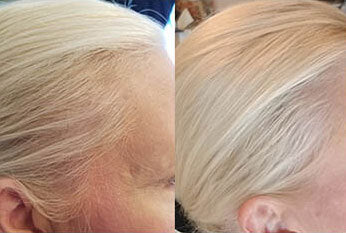Your Cart is Empty
20% off with "BF25" at checkout
20% off with "BF25" at checkout
20% off with "BF25" at checkout
March 28, 2025 4 min read
Hair loss in women presents itself in numerous ways, with one distinctly alarming feature being the thinning of hair at the back of the head. Although more subtle and less frequently discussed compared to front hairline thinning or overall volume loss, noticeable decrease in thickness at the back of the scalp can be both distressing and perplexing to many women.
Women experiencing hair loss at the back of the head may feel isolated and unsure about the underlying causes and effective treatment options. This article aims to unravel some of the reasons behind this troubling issue, explores available treatments, and offers actionable advice to support hair health and confidence.
Various factors contribute to the phenomenon of hair thinning at the back of the head in women. Unlike the male pattern of baldness, which typically shows as a receding hairline or noticeable scalp exposure at the crown, women’s hair thinning is usually more diffused, but can concentrate noticeably at the posterior portion of the scalp.
A common culprit behind hair thinning in women is androgenetic alopecia, also referred to as female pattern hair loss. Unlike the characteristic male pattern baldness, female pattern hair loss tends to start with a widening part followed by diffuse thinning at the crown and back region. This is primarily influenced by genetics, hormones, and overall hair health.
Additionally, hormonal fluctuations during menopause, pregnancy, childbirth or even certain medical conditions such as polycystic ovary syndrome (PCOS) and hypothyroidism can trigger significant hair thinning in these specific areas. Nutrient deficiencies such as iron, vitamin D, and B-vitamins deficiency also contribute to diffuse thinning at the back of the head.
If you've noticed your hair becoming sparse at the back of your scalp, early detection increases the chance of successful treatment. Seeking professional consultation promptly from a dermatologist or trichologist is highly beneficial. Initially, doctors assess your medical history, diet, stress levels, and medication intake to pinpoint contributing factors.
In some instances, specialists might recommend further testing, such as blood tests to rule out nutritional deficiencies or hormonal imbalance, or even scalp biopsies in specific cases. Proper assessment ensures that treatments address the root cause rather than merely masking symptoms.
Depending on the identified factors contributing to hair thinning, several effective solutions — medical, nutritional, lifestyle-based, or even cosmetic — could help restore volume and confidence.
Medical treatments often include topical minoxidil solutions, effective in stimulating hair follicles. Oral medications like spironolactone or hormonal supplements are sometimes recommended by medical professionals, particularly when hormonal imbalance is evident. Laser therapy, such as Low-Level Laser Therapy (LLLT), is also gaining traction due to its potential benefits in rejuvenating hair growth on the scalp.
Lifestyle changes such as a balanced diet rich in nutrients, regular exercise to stimulate circulation, stress reduction techniques, and gentle hair care routines avoiding tight hairstyles and harsh chemicals can have positive impacts on restoring hair thickness at the back of the head.
Specialised hair growth products incorporating proven ingredients are rising in popularity due to their non-invasive nature and ease of application. Topical serums containing clinically tested ingredients like biotin, peptides, saw palmetto or caffeine have demonstrated impressive results for many women.
One exceptional option to consider is the hair growth serum, Folliboost. Designed specifically for women's unique hair loss patterns, Folliboost utilises powerful yet gentle ingredients to rejuvenate thinning follicles at the back of your head, promoting thicker, fuller hair growth. Trust this advanced formulation to help regain your hair confidence again.
While waiting for effective treatments to kick into action, temporary styling solutions might mitigate feelings of self-consciousness associated with visible hair thinning. Consider layered cuts to create volume and movement, strategic colouring or highlights to conceal and camouflage thinning patches visually.
Moreover, scalp powders and coloured sprays matched to your hair colour provide immediate coverage, discreetly filling sparse areas and giving an instant appearance of density.
Feeling stressed, anxious, or embarrassed by hair thinning at the back of your head is entirely understandable. However, remember you’re not alone—millions of women worldwide face a similar issue.
Connecting with online or in-person support groups provides valuable emotional support while exchanging solutions and encouraging experiences with others undergoing similar struggles. Additionally, engaging closely with healthcare practitioners can reassure and equip you with comprehensive guidance and positive outcomes.
Hair thinning at the back of the head in women is a manageable, frequently treatable issue. Prompt recognition and diagnosis, coupled with proactive treatment strategies and supportive solutions, can make a tremendous difference.
By understanding the underlying causes, addressing contributing factors, and utilising effective treatments available today—including targeted hair growth solutions like Folliboost—women can regain control of their hair health, restoring not only scalp coverage but confidence in their daily lives.
